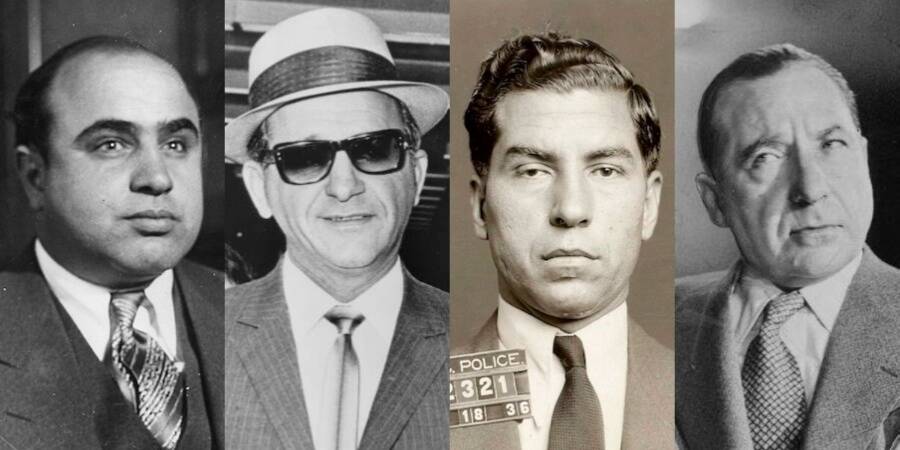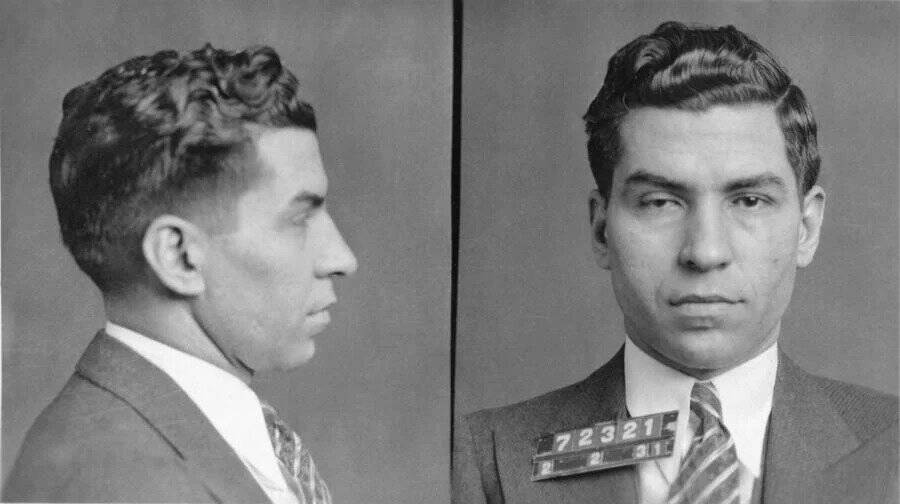From the Five Families of the New York Mafia to organized crime kingpins in Chicago and beyond, these mob bosses ruthlessly ruled the underworld.

Getty Images, Wikimedia CommonsFrom left, Al Capone, Sam Giancana, Lucky Luciano, and Frank Costello, some of the most powerful and feared mob kingpins in history.
For decades, beloved films and TV shows like The Godfather and The Sopranos have given viewers a glimpse of what life is like inside the Mafia. And though fictional characters like Vito Corleone and Tony Soprano were actually based on real-life Mafia bosses, the true stories of the American mob and its kingpins are far more sensational than any fictional narrative could ever depict.
The modern American Mafia began to take shape in the 1920s, mostly in and around New York City, when a perfect storm of immigration trends and alcohol restrictions created the conditions for the birth of a criminal underworld. As members of the Sicilian Mafia fled the Fascist regime of Benito Mussolini back in Italy, Italian-Americans and other ethnic groups started to profit from bootlegging illegal alcohol during Prohibition.
This union of Italian-Americans bootleggers and Sicilian Mafiosi led to the birth of the American Mafia (distinct from the Mafia back in Italy, though it retained some of the old traditions). And it didn’t take long for things to get violent.
At the end of the 1920s, a bloody conflict called the Castellammarese War broke out between the two most powerful New York City gangs, one led by Salvatore Maranzano, the other by Joe Masseria. Maranzano came out on top when he had Masseria assassinated in 1931, and crowned himself capo di tutti capi, boss of all bosses. Then, he set out to reorganize things.
Maranzano created a power structure within the American Mafia known as the “Five Families,” which were then known as Luciano, Gagliano, Mangano, Maranzano, and Profaci, each named for the man who would lead it and each with its own territory. These men were the first generation of Mafia bosses in the modern sense and they governed their respective “families” with the help of underbosses, lieutenants known as capos, and soldiers.
But this structure also gave rise to resentment toward Maranzano. As the “boss of all bosses,” he claimed to have more power than the others. Soon enough, Luciano Family boss Lucky Luciano had Maranzano killed. Afterward, Luciano did not name himself capo di tutti capi, though he did otherwise maintain the structure that Maranzano had set up.
Furthermore, in the aftermath of Maranzano’s murder, Luciano established the “Commission,” an umbrella Mafia organization that acted as a governing body. In addition to the Five Families, it also oversaw families outside of New York City, families that operated across the country.
And though, at this same time, Prohibition ended the Mafia’s bootlegging operation, mob bosses quickly pivoted to other pursuits. In the mid-20th century, Mafia bosses integrated themselves both into legitimate businesses like garbage collection as well as illicit ones like gambling.
By the time it hit its peak circa the 1950s, the American Mafia had thousands of members and two dozen families. And these families were governed by Mafia bosses, men who were cunning and ruthless enough to rise to the top of their respective organizations.
These are the stories of 13 of the most notorious Mafia bosses in American history, from Lucky Luciano to John Gotti to Al Capone.
How Mafia Boss Lucky Luciano Built The Mob As We Know It

Wikimedia CommonsLucky Luciano helped take down not one but two powerful mob bosses before he set out to organize the American Mafia.
Long before he was called “Lucky,” Charles Luciano was born as Salvatore Lucania in Sicily on Nov. 24, 1897. He and his family moved to New York City when Luciano was around the age of 10, and Luciano struggled in school but thrived among the criminal element of the Lower East Side.
Before long, Luciano was charging his schoolmates for “protection,” pickpocketing oblivious passersby, and selling drugs. He also struck up profitable friendships with two members of Jewish gangs: Meyer Lansky and Benjamin “Bugsy” Siegel.
Along the way, Luciano transformed himself from Salvatore Lucania to Charles Luciano, purportedly because he thought “Sal” or “Sally” wasn’t masculine. He also allegedly earned the nickname “Lucky” in 1929 when he survived a brutal attack from fellow gangsters. They beat him, stabbed him, and slit his throat before leaving him for dead on a local beach.
Soon after Lucky Luciano survived the beating, but he’d go on to play a crucial role in the Castellammarese War that broke out in 1930 between rival Mafia bosses Joe Masseria and Salvatore Maranzano. Though Luciano was an ally of Masseria, he made a deal with Maranzano to help assassinate Masseria if it could bring the bloody conflict to a close.
“Do you know why you are here?” Maranzano allegedly asked Luciano and his fellow gangster Vito Genovese. When they nodded, Maranzano said: “Good. I don’t have to tell you what needs to be done… I’m looking forward to a peaceful Easter.”
On April 15, 1931, Masseria went to have dinner in Coney Island, Brooklyn. As The New York Times notes, most accounts of this infamous dinner state that Luciano met Masseria there but excused himself to go to the bathroom. At that point, other mobsters burst in and killed Masseria.

Bettmann/Getty ImagesThe body of Joe Masseria just after his assassination in April 1931.
In the aftermath, Luciano also turned on Maranzano, who he had killed just months later. Then Luciano set out to bring order to the American Mafia through the creation of an overarching, nationwide governing body called the “Commission.”
He lived the high life as a Mafia boss and de facto Commission head for several years, but was convicted of extortion and prostitution in 1936, and deported back to Italy in 1946. Despite his violent life, Lucky Luciano didn’t die at the hands of another mob boss but instead of a fatal heart attack that struck on Jan. 26, 1962 — just before Italian authorities intended to arrest him for drug trafficking.





